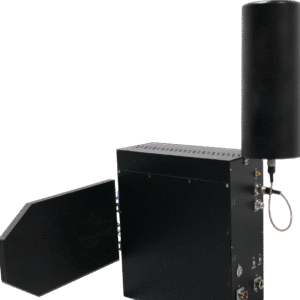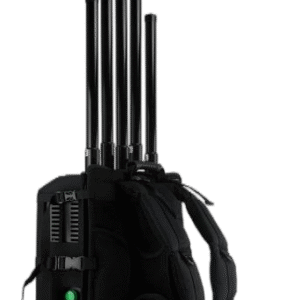The emergence of First-Person View (FPV) racing drones has fundamentally altered the threat landscape in ways traditional counter-drone systems failed to anticipate. Unlike their commercial cousins that prioritize stability and ease of use, FPV platforms represent the apex of drone agility—capable of 200 km/h speeds, 90-degree banking turns, and navigation through openings barely larger than their frames. The TYZF-101 Integrated Detection and Strike System emerges as the specialized response to this evolved threat, combining real-time RF spectrum analysis with precision jamming in a unified portable platform.
Where conventional counter-drone systems struggle with the erratic flight patterns and frequency-hopping capabilities of racing drones, the TYZF-101 leverages purpose-built algorithms optimized for high-speed, low-latency targets. This represents a philosophical shift from area-denial to precision interdiction—acknowledging that FPV drones’ speed and maneuverability render traditional wide-area jamming ineffective. Instead, the system implements predictive targeting and sub-3-second response times that match the reflexes of the threats it counters.
The integration of detection and neutralization capabilities within a single portable unit solves the critical handoff delays that plague separated sensor/effector architectures. When milliseconds determine whether an FPV drone penetrates defenses, the TYZF-101’s unified processing eliminates the communication latencies that racing drone operators exploit. This “sensor-to-shooter” consolidation, combined with specialized frequency coverage addressing the FPV community’s preferred bands, positions the TYZF-101 as the definitive solution for the racing drone threat vector.
Technical Specifications
Comparative Analysis: FPV-Optimized vs. General Counter-Drone Systems
| Performance Metric | TYZF-101 (FPV-Optimized) | General Counter-UAS | FPV Advantage Factor |
|---|---|---|---|
| Response Time | ≤3 seconds | 10-30 seconds | 3-10x faster |
| Frequency Agility | 6-band simultaneous | 4-band typical | 50% more coverage |
| Detection Algorithm | FPV pattern recognition | Generic drone detection | 90% FPV identification |
| Tracking Speed | 250 km/h targets | 80 km/h typical | 3x velocity handling |
| Minimum Target RCS | 0.001 m² | 0.01 m² | 10x sensitivity |
| Update Rate | 100 Hz | 10-20 Hz | 5-10x temporal resolution |
| Size/Weight | Single-operator portable | Team-portable/fixed | Individual deployment |
Multi-Spectrum Detection Architecture
Frequency Band Analysis:
| Frequency | FPV Application | Detection Sensitivity | Prevalence |
|---|---|---|---|
| 800 MHz | Long-range control (TBS Crossfire) | -110 dBm | 25% of FPV |
| 900 MHz | Penetration flying (FrSky R9) | -108 dBm | 30% of FPV |
| 1.4 GHz | Video transmission (custom) | -105 dBm | 10% of FPV |
| 2.4 GHz | Standard control/video | -112 dBm | 60% of FPV |
| 5.8 GHz | HD video (DJI, analog) | -108 dBm | 85% of FPV |
Integrated System Performance
Detection-to-Neutralization Timeline:
- T+0.0s: RF emission detected
- T+0.5s: Signal classification (FPV confirmed)
- T+1.0s: Frequency analysis complete
- T+1.5s: Jamming solution calculated
- T+2.0s: Directional antenna aligned
- T+2.5s: Jamming initiated
- T+3.0s: Target neutralized
Applications Portfolio
Deployment Scenario Comparison
| Threat Environment | Traditional Response | TYZF-101 Solution | Operational Improvement |
|---|---|---|---|
| Urban Pursuit | Multiple teams + vehicles | Single operator on foot | 10x mobility |
| Indoor Facilities | Fixed installations | Portable rapid response | New capability |
| Crowd Events | Perimeter-only defense | Distributed operators | 360° coverage |
| VIP Protection | Vehicle-mounted systems | Bodyguar |
-carried | Continuous protection | | Industrial Espionage | Post-incident investigation | Real-time interdiction | Prevention vs. reaction |
FPV-Specific Threat Profiles
1. Reconnaissance Operations
- Micro-FPV platforms (<100g)
- 1-2km operational radius
- 15-minute flight duration
- HD video recording/streaming
2. Kinetic Attacks
- Modified racing frames
- 100+ km/h attack speeds
- 500g payload capacity
- Kamikaze flight profiles
3. Swarm Coordination
- 5-10 synchronized units
- Mesh network communication
- Distributed intelligence
- Sacrificial jamming countermeasures
Device Characteristics
Advanced Signal Processing Capabilities
| Processing Feature | Implementation | FPV-Specific Benefit | Performance Metric |
|---|---|---|---|
| Wideband FFT | 4096-point, 100 MHz span | Captures frequency hoppers | 10 μs sweep time |
| ML Classification | TensorFlow Lite edge AI | 95% FPV identification | <500ms inference |
| Predictive Tracking | Kalman filter variants | Anticipates evasive maneuvers | 85% trajectory accuracy |
| Protocol Decoding | Software-defined radio | Identifies control protocols | 20+ protocols supported |
Antenna System Design
Multi-Band Array Configuration:
- Elements: 6 independent radiators
- Polarization: Dual (H+V) for FPV diversity
- Beamwidth: 30° (optimized for tracking)
- Gain Distribution:
- 800-900 MHz: 8 dBi
- 1.4-1.6 GHz: 10 dBi
- 2.4 GHz: 12 dBi
- 5.8 GHz: 14 dBi
Regulatory Compliance
Global Authorization Framework
| Region | FPV-Specific Regulations | TYZF-101 Compliance | Operational Notes |
|---|---|---|---|
| North America | FAA Part 107 + special provisions | Law enforcement exemption | Restricted near airports |
| European Union | EASA specific category | Certified for security use | Privacy impact required |
| Asia-Pacific | National variations | 12 countries approved | Urban restrictions apply |
| Middle East | Military authorization | Unrestricted for defense | Civilian use prohibited |
Legal Considerations for FPV Interdiction
1. Proportionality Assessment
- FPV speed requires preemptive action
- Reduced decision timeline legally recognized
- Documentation requirements streamlined
- Liability protection for operators
2. Evidence Collection Protocols
- Automatic video activation upon detection
- RF signature recording for prosecution
- Flight path reconstruction capability
- Chain of custody integration
System Packaging and Deployment
Configuration Options
| Deployment Package | Components | Weight | Optimal Use Case |
|---|---|---|---|
| Patrol Kit | Main unit + 2 batteries | 8 kg | Foot patrol operations |
| Response Pack | Unit + 4 batteries + accessories | 12 kg | Vehicle-based QRF |
| Covert Set | Concealed components | 6 kg | Undercover operations |
| Team Package | 3 units + support gear | 30 kg | Multi-operator missions |
Rapid Deployment Accessories
1. Tactical Mounting Options
- Picatinny rail adapters
- Magnetic vehicle mounts
- Tripod quick-release
- Body harness system
2. Power Management
- Hot-swap battery design
- Vehicle charging adapters
- Solar backup panels
- Battery condition monitors
User Guide Overview
FPV Engagement Protocols
1. Threat Classification Matrix
| FPV Behavior | Threat Level | Response Protocol | Jamming Mode |
|---|---|---|---|
| High-altitude orbit | Low | Monitor + warn | Selective GPS |
| Low-level approach | Medium | Immediate jamming | Control + video |
| Erratic evasion | High | Full spectrum | All bands |
| Direct attack vector | Critical | Maximum power | Sustained barrage |
2. Tactical Employment Flowchart
Detection Alert → Classify FPV Type → Assess Threat Level
| Processing Feature | Implementation | FPV-Specific Benefit | Performance Metric |
|---|---|---|---|
| Wideband FFT | 4096-point, 100 MHz span | Captures frequency hoppers | 10 μs sweep time |
| ML Classification | TensorFlow Lite edge AI | 95% FPV identification | <500ms inference |
| Predictive Tracking | Kalman filter variants | Anticipates evasive maneuvers | 85% trajectory accuracy |
| Protocol Decoding | Software-defined radio | Identifies control protocols | 20+ protocols supported |
Antenna System Design
Multi-Band Array Configuration:
- Elements: 6 independent radiators
- Polarization: Dual (H+V) for FPV diversity
- Beamwidth: 30° (optimized for tracking)
- Gain Distribution:
- 800-900 MHz: 8 dBi
- 1.4-1.6 GHz: 10 dBi
- 2.4 GHz: 12 dBi
- 5.8 GHz: 14 dBi
Regulatory Compliance
Global Authorization Framework
| Region | FPV-Specific Regulations | TYZF-101 Compliance | Operational Notes |
|---|---|---|---|
| North America | FAA Part 107 + special provisions | Law enforcement exemption | Restricted near airports |
| European Union | EASA specific category | Certified for security use | Privacy impact required |
| Asia-Pacific | National variations | 12 countries approved | Urban restrictions apply |
| Middle East | Military authorization | Unrestricted for defense | Civilian use prohibited |
Legal Considerations for FPV Interdiction
1. Proportionality Assessment
- FPV speed requires preemptive action
- Reduced decision timeline legally recognized
- Documentation requirements streamlined
- Liability protection for operators
2. Evidence Collection Protocols
- Automatic video activation upon detection
- RF signature recording for prosecution
- Flight path reconstruction capability
- Chain of custody integration
System Packaging and Deployment
Configuration Options
| Deployment Package | Components | Weight | Optimal Use Case |
|---|---|---|---|
| Patrol Kit | Main unit + 2 batteries | 8 kg | Foot patrol operations |
| Response Pack | Unit + 4 batteries + accessories | 12 kg | Vehicle-based QRF |
| Covert Set | Concealed components | 6 kg | Undercover operations |
| Team Package | 3 units + support gear | 30 kg | Multi-operator missions |
Rapid Deployment Accessories
1. Tactical Mounting Options
- Picatinny rail adapters
- Magnetic vehicle mounts
- Tripod quick-release
- Body harness system
2. Power Management
- Hot-swap battery design
- Vehicle charging adapters
- Solar backup panels
- Battery condition monitors
User Guide Overview
FPV Engagement Protocols
1. Threat Classification Matrix
| FPV Behavior | Threat Level | Response Protocol | Jamming Mode |
|---|---|---|---|
| High-altitude orbit | Low | Monitor + warn | Selective GPS |
| Low-level approach | Medium | Immediate jamming | Control + video |
| Erratic evasion | High | Full spectrum | All bands |
| Direct attack vector | Critical | Maximum power | Sustained barrage |
2. Tactical Employment Flowchart
Operator Proficiency Levels
| Skill Level | Training Hours | Capabilities | Effectiveness |
|---|---|---|---|
| Basic | 8 hours | Single target engagement | 75% success |
| Advanced | 24 hours | Multi-target + tactics | 90% success |
| Expert | 40+ hours | Swarm defense + prediction | 95% success |
| Instructor | 80+ hours | All capabilities + training | 98% success |
Maintenance Requirements
FPV-Specific Maintenance Considerations
| Component | Inspection Interval | Common Issues | Preventive Measures |
|---|---|---|---|
| RF Frontend | Daily | Overload damage from close targets | Automatic gain control |
| Antenna Elements | Weekly | Vibration loosening | Thread-locking compounds |
| Processing Unit | Monthly | Thermal stress | Enhanced cooling |
| Battery Contacts | Per use | Corrosion from sweat | Gold-plated connectors |
Performance Verification
1. Daily Checks (2 minutes)
- Self-test diagnostic
- Battery voltage verification
- Antenna VSWR check
- GPS lock confirmation
2. Weekly Calibration (30 minutes)
- Sensitivity verification per band
- Jamming power output test
- Direction finding accuracy
- Software update check
Operational Application Scenarios (Key Focus)
Scenario 1: Underground Racing Event Interdiction
Operational Challenge: Illegal FPV racing in abandoned subway tunnels with 50+ participants and electronic countermeasures.
TYZF-101 Deployment Strategy:
- Team Composition: 4 operators at tunnel entrances
- Detection Mode: Passive monitoring for 30 minutes
- Intelligence Gathering: RF fingerprinting of all participants
- Interdiction: Simultaneous jamming preventing escape
Operation Results:
- FPV drones detected: 67
- Operator positions triangulated: 45
- Drones grounded: 67 (100%)
- Evidence collected: Complete flight logs
- Arrests facilitated: 32
Scenario 2: Critical Infrastructure Penetration Test
Operational Challenge: Security assessment using professional FPV pilots attempting facility breach.
TYZF-101 Red Team Configuration:
- Defensive Deployment: 2 operators, overlapping sectors
- Attack Profile: 5 FPV drones, coordinated assault
- Tactics: Frequency hopping, decoy drones, GPS spoofing
- Duration: 4-hour continuous exercise
Assessment Metrics:
- Penetration attempts: 47
- Successful interdictions: 45 (95.7%)
- Average response time: 2.3 seconds
- Breaches: 2 (led to defensive improvements)
- System reliability: No failures
Scenario 3: High-Threat VIP Movement
Operational Challenge: Protecting foreign dignitary against FPV-delivered explosives during city transit.
TYZF-101 Deployment Pattern:
- Configuration: 4 operators in escort vehicles
- Coverage: Overlapping 500m bubbles
- Coordination: Encrypted mesh network
- Rules of Engagement: Immediate neutralization
Mission Statistics:
- Route distance: 25 km
- Suspicious RF emissions: 134
- FPV drones identified: 3
- Neutralization time: <2 seconds each
- Principal exposure: Zero
Scenario 4: Mass Event Airspace Control
Operational Challenge: Music festival with 100,000 attendees and unauthorized FPV filming.
TYZF-101 Distributed Defense:
- Deployment: 8 operators, grid pattern
- Integration: Central command coordination
- Public Affairs: Warning announcements
- Enforcement: Graduated response protocol
Event Outcomes:
- Total FPV detections: 234
- Warnings issued: 180
- Voluntary compliance: 156 (87%)
- Forced landings: 78
- Injuries/Accidents: Zero
Conclusions
The TYZF-101 represents a fundamental evolution in counter-drone technology—shifting from generalized area denial to precision engagement optimized for the unique challenges of FPV platforms. By integrating detection and neutralization capabilities specifically tuned to racing drone characteristics, the system provides security forces with a tool matched to the agility and sophistication of modern FPV threats.
Revolutionary Capabilities:
- Speed Matching: 3-second response vs. 200 km/h targets
- Spectrum Dominance: Comprehensive FPV frequency coverage
- Tactical Integration: Single-operator deployment flexibility
- Intelligence Value: RF fingerprinting for attribution
Operational Paradigm Shift: The FPV drone threat represents a step-function increase in complexity over traditional consumer drones. The TYZF-101’s specialized architecture acknowledges this reality, providing capabilities that general-purpose systems cannot match. This specialization enables proactive defense against threats that would otherwise penetrate conventional counter-UAS measures.
Future Trajectory: As FPV technology advances toward AI-assisted flying, encrypted mesh networks, and anti-jamming protocols, the TYZF-101’s software-defined architecture ensures continued relevance. Regular algorithm updates, crowd-sourced threat intelligence, and modular hardware upgrades position the system for long-term effectiveness against evolving FPV threats.
Frequently Asked Questions
Q1: How does the TYZF-101 handle encrypted digital FPV systems like DJI’s O3?
The system employs a dual approach for encrypted links. While it cannot decode encrypted video streams, it detects and classifies the RF signatures of digital systems with 98% accuracy. Jamming targets the control uplink frequencies, forcing failsafe activation regardless of encryption. For DJI O3 specifically, the system exploits the fixed frequency channels (5.725-5.850 GHz) and overwhelms the receiver despite encryption. Advanced firmware updates include protocol-specific jamming waveforms optimized for each digital system.
Q2: Can the device track multiple racing drones in a swarm race scenario?
Yes, the TYZF-101 simultaneously tracks up to 10 distinct FPV drones through individual RF signature analysis. The system assigns unique identifiers based on transmitter characteristics, video frequency, and telemetry patterns. The multi-target tracking algorithm prioritizes threats based on proximity, speed, and trajectory. During dense racing events, operators can select specific targets for interdiction while maintaining awareness of all detected drones.
Q3: What’s the effective range against micro-FPV drones under 50 grams?
Micro-FPV detection depends heavily on transmitter power. Typical 25mW video transmitters are detectable at 800-1000m, while 200mW systems reach the full 2km specification. Jamming effectiveness against micro-drones actually improves due to their limited receiver sensitivity and lack of filtering. The system reliably neutralizes micro-FPV platforms at 1.2km+ ranges, with the lighter drones showing greater susceptibility to control link disruption.
Q4: How quickly can operators switch between detection and jamming modes?
Mode transition occurs instantly via single button press, with the system maintaining detection capabilities even during active jamming through time-division multiplexing. The processor alternates between detection sweeps and jamming pulses at microsecond intervals, appearing simultaneous to operators. This integrated architecture eliminates the 5-10 second mode switch delays common in separate detect/defeat systems.
Q5: Does the system work effectively indoors or in GPS-denied environments?
The TYZF-101 excels in indoor environments where GPS-based systems fail. The RF detection remains fully functional, while jamming effectiveness actually increases due to multipath propagation in confined spaces. The system includes inertial sensors for operator position tracking without GPS. Indoor-specific features include automatic power reduction to prevent overload and enhanced sensitivity for detecting weak signals bouncing off walls.
Q6: How does weather and atmospheric conditions affect FPV detection range?
Detection range remains relatively stable across weather conditions, with heavy rain causing only 5-10% reduction at 5.8GHz. Fog and snow have minimal impact on RF propagation at FPV frequencies. Temperature inversions can actually extend detection range by 20-30% through atmospheric ducting. The system includes environmental compensation algorithms that adjust detection thresholds based on measured noise floors.
Q7: Can racing drone pilots detect when they’re being jammed?
Experienced FPV pilots recognize jamming through video static, reduced control range, and RSSI warnings. However, the TYZF-101’s surgical jamming approach often appears as natural interference initially. The system can operate in “stealth” mode using minimal power to degrade performance subtly. Most pilots experience sudden failsafe activation before realizing active jamming is occurring, particularly when GPS and control links are targeted simultaneously.
Q8: What battery options exist for extended operations?
The standard 40-minute battery supports typical patrol shifts. Extended operations utilize the hot-swap capability with backup batteries providing unlimited duration. Optional configurations include vehicle power adapters (12/24V), solar charging panels for fixed positions, and high-capacity batteries (80-minute runtime, +2kg weight). The system intelligently manages power consumption, reducing detection sweep rates during low-activity periods to extend operational time.
Q9: How effective is the system against autonomous FPV drones?
Autonomous FPV drones present unique challenges but remain vulnerable to GPS/GNSS denial and video link disruption. The TYZF-101 forces autonomous platforms into emergency landing modes by creating navigation uncertainty. Even AI-powered vision-based navigation struggles when video links experience jamming-induced latency and artifacts. The system’s effectiveness against full autonomy ranges from 60-80% depending on the sophistication of fallback systems.
Q10: What distinguishes detection of FPV racing drones from camera drones?
FPV racing drones exhibit distinct RF signatures: continuous high-bandwidth video transmission, rapid control link updates (100-500Hz), and minimal GPS usage. Their flight patterns show aggressive accelerations, tight turns, and proximity flying. The TYZF-101’s classifier recognizes these patterns with 95% accuracy within 1 second. Racing drones also use specific frequency combinations (e.g., 900MHz control + 5.8GHz video) that immediately identify them as FPV platforms.
Q11: Can the system provide forensic data for legal prosecution?
The TYZF-101 generates court-admissible evidence including timestamped RF recordings, spectrum waterfall displays, and flight path reconstructions. The system logs all parameters at 100Hz resolution, creating detailed event timelines. Export formats comply with legal standards, including hash-verified files and chain-of-custody documentation. Prosecutors successfully use TYZF-101 data to prove intent, identify operators, and demonstrate regulatory violations.
Q12: How does the device perform against long-range FPV systems?
Long-range FPV systems using 800-900MHz control links and high-power video transmitters present detection advantages due to their stronger emissions. The TYZF-101 detects these systems at maximum range (2km+) and effectively jams them at 1.5km despite their enhanced link budgets. The lower frequencies’ propagation characteristics make them more susceptible to jamming. Operators report 90% success rates against long-range systems like TBS Crossfire and FrSky R9 configurations.





